About Maple Syrup
Spout on a Tree?
Making maple syrup is a straightforward process, involving reducing maple sap to concentrate the sugar. But it is not quite so simple as walking up to a tree and opening a spigot.
Legend has it that Chief Woksis of the Iroquois Tribe in Central New York threw a knife or hatchet at a maple tree and a bowl below the tree collected the sap. His wife tasted it and boiled dinner in the sweet liquid.
Today, it can be as simple as drilling a hole in the backyard maple, putting a small spout in to funnel the sap, and collecting it in a bucket. Then the sap is collected and boiled – best to do it on an outdoor burner so that the sticky steam doesn’t coat the kitchen. Once the liquid reaches 7 degrees above the boiling point of water, it is syrup.
To make syrup in large amounts, however, the process is a bit more complicated. A system of tubes brings sap to the sugarhouse, where it is transformed into syrup. We have approximately 30 miles of pipe and tube in the woods that come to the sugarhouse.
Sugar or Syrup
Maple syrup is a liquid, so why do we make it in a sugarhouse? Well, in the Northeast, the terms are used almost interchangeably. And, an easy way to understand it is that the sugar content is what is measured at each step of the process. So, the person who makes the syrup (Dan!) is referred to as a sugarmaker and the syrup is made in a sugarhouse. And the trees on the hill, that’s our sugarbush.
Of course, syrup is sometimes boiled down even further until a dry sugar is made. That is called “maple sugar” while maple syrup is simply called what it is.
Sugar Maple, Red Maple, Maple
There are several different maples at Buckwheat Hill Farm. The majority of the maples that we tap are sugar maples, also called a hard maple. The sugar maple is the gold standard in Vermont and elsewhere for tapping. The sugar maple generally will give about 2 percent sugar. When the sap comes out of the tree in the springtime it’s mostly water, so 2% sugar means that there is 98% water.
The other type of maple that we tap is called a red maple, also commonly called a soft maple. Although lower in sugar content, it still creates a very nicely flavored maple syrup, especially when mixed with our sugar maples. The soft maple produces 1 ½ to 2% sugar.
There are also have a few silver maple hybrids on the property, called a sweet silver maple. These produce 5 to 7% sugar. We planted these and, although they are not large enough to tap yet, we are eager to see how they do.
From Tree to Sugarhouse
Making maple syrup is fundamentally a simple process: put a hole in a tree, gather the sap, boil it until it is 7° above boiling point of water. Then you have maple syrup. Back in the days of the family farm, extended family, cousins, uncles, children – everyone would get together to help make maple syrup. So collecting several hundred buckets that were hung on a tree, although still a daunting task was not that big of a deal. Today, modern technology has allowed maple syrup to be made even when not as many hands are available to pitch in. A tubing system allows us to bring the sap directly from the tree right into the sugarhouse without having to traipse through the woods every day.
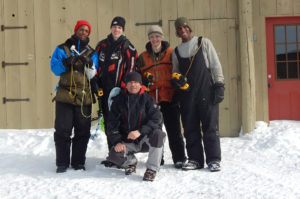
Tapping the Trees and Gathering Sap
Every January, on days when the temperature is above 10°F, we’re in the sugarbush tapping our trees. The tapping process starts with drilling a 5/16-inch hole in the tree, with essentially what is a portable drill press called the precision tapper.
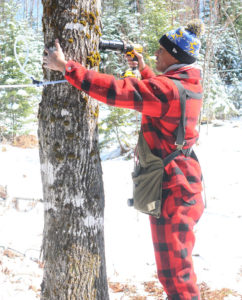
This allows for a very nice neat clean hole so that when you put the spout in the tree, it makes a nice tight seal. Into the hole, we put a nylon spout. The spout is then connected to the tubing that is connected all the way to sugarhouse. The tubing is also 5/16 inch and it is translucent so that light can get through it to melt the ice that forms. The tubing connects to 1 inch mainlines, which then connect to 1 ½ inch conductor lines that come all the way to the sugarhouse.
There are two forces helping the sap to reach the sugarhouse.
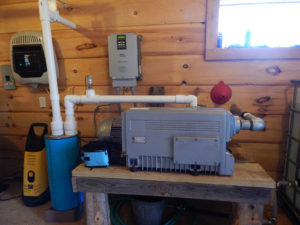
One is a vacuum pump that is at the sugarhouse. The pump creates a vacuum at every hole and also helps evacuate the sap out of the tubing. The other force is gravity. Once the sap reaches the main line, gravity is the leading force that takes it all the way to the sugarhouse.
Reverse Osmosis
At the sugarhouse, the sap enters a releaser, which allows the sap to be released into a gathering tank without losing vacuum. At the end of each day, we process the sap through a reverse osmosis machine.
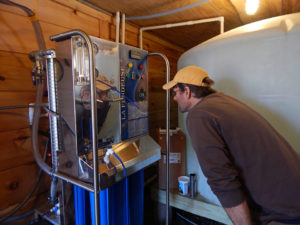
The reverse osmosis process takes out a tremendous amount of water, up to 90%, which cuts down on the boiling time. The concentrated sap that comes out of the reverse osmosis process is pumped up onto a tank above the evaporator, ready to be boiled into syrup.
Boiling
From the concentrate tank, the concentrated sap goes through a series of pre-heaters that are hot from the steam given off by the evaporator.
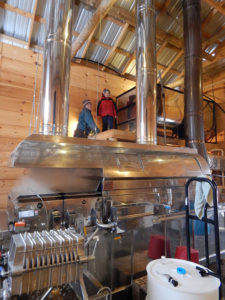
The heated sap drops into the back of the evaporator. As the sap starts to boil, it gets heavier, which moves it forward in the very slightly sloped pans. The front pans are called the finishing pans. In the front pan, a temperature probe is set to 7° above the boiling point of water. At that point, the sap is syrup and an automatic spout opens to allow it to come out. The automatic drawing off of the syrup is essential when there’s only one person keeping an eye on the whole process.
The syrup is pumped through a filter and into 40 gallon barrels for storage.
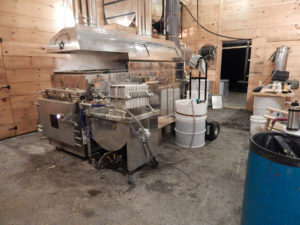
At Buckwheat Hill Farm, we have the capacity to make about a barrel an hour.
Bottling
Our bottling machine, also called a canning machine, is a water-jacketed 40-gallon rectangular stainless steel bin. The water is heated to 185°, which in turn heats the bin of syrup. At this temperature, the maple syrup is heat sealed into our bottles. We hand bottle all of our containers, both glass and plastic.
All Natural
At Buckwheat Hill Farm, we value our maple syrup and we value our trees. We do not and will not use chemicals or processes that would harm our trees or our syrup. Although there is a process for becoming certified organic, it is quite expensive and has very little to do with the actual syrup (and odd rules, like distance of trees from property lines). We follow the best practices and keep up with research done by the University of Vermont’s Proctor Research Center as well as the research center at Cornell University.
We use only food grade materials in the processing of our sap into syrup. We are proud of our syrup and want to only offer the best, plus we eat it ourselves (a lot!).
Grades of Syrup
The Vermont Agency of Agriculture updated the naming conventions for maple syrup in 2014. All syrup sold to consumers is Grade A. The names are
• Golden Color/Delicate Taste
• Amber Color/Rich Taste
• Dark Color/Robust Taste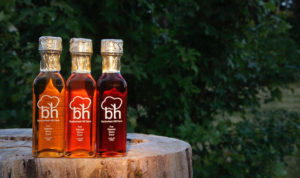
Of course, we love all of these. The Golden Color/Delicate Taste is equivalent to what was previously known as Fancy. Many people like the slightly stronger maple flavor of the Amber Color/Rich Taste for their pancakes/waffles/ice cream/tea. The Dark Color/Robust Taste is great for cooking because the flavor of maple will hold up, even in baked goods. One day, I might even share my variation of my great-grandmother’s Pecan Pie made with our Vermont maple syrup . . .

